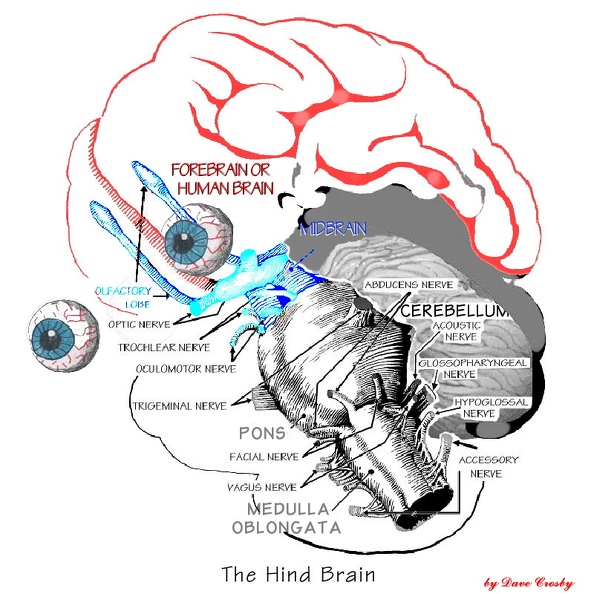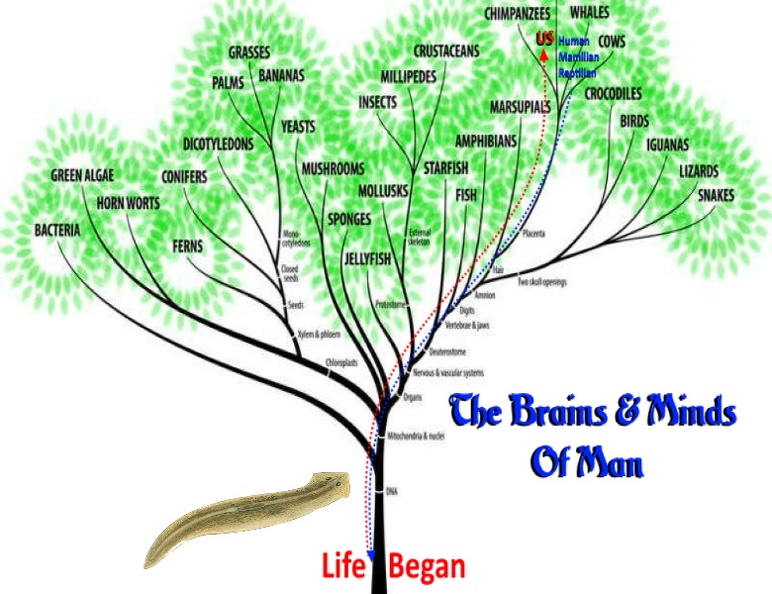Post by 1dave on Mar 22, 2020 9:05:55 GMT -5
BRAIN STRUCTURES and MIND FUNCTIONS
a closer look at our “Mental Faculties.”
Who Am I?
We think we are our “Right Now principle Awareness,”
We think we are our “Right Now principle Awareness,”
BUT our Central Nervous System is constantly SHIFTING our principal awareness! Our brains constantly receive external and internal stimuli that must be:
- - 1. Received by brain cells dedicated to that particular type and range of stimulus, then connected to other brain cells to be
- - 2. Compared to previously received stimuli, connected to more cells where they can be
- - 3. Identified as to their exact nature, shifted to yet other cells to be
- - 4. Interpreted as to present meaning, more shifting back and forth to be
- - 5. Verified that the identification and interpretation is accurate, then forwarded to the cells that must then
- - 6. Decide how to proceed, and finally to the cells that
- - 7. Initiate the action indicated.
Awareness is shifted through various Arousal Levels. Awareness is shifted from one emotion to another. Awareness is also shifted from detection of internal chemical information like smell, taste, discomfort, pain AND EMOTION, to detection of external electromagnetic vibrational signals such as sight, sound, and touch .
Some of us specialize in thinking in images, sound (words), physical movement, analytical, emotional . . .
AND then Finally, awareness is shifted back and forth between at least TEN physically separate brain systems, each of which has it’s unique specialty and provides a multitude of separate paths within that specialty.
As each path has it’s own objective and opinion as to WHO YOU ARE and WHAT YOU SHOULD BE DOING, Our behavior changes with each path, - - -
but we still think
“This is ME.”
“This is ME.”
No wonder we have paradoxical behavior, and feel we are inconsistent!
Lets take a closer look at our brains . . .

Complicated huh?
Well, we are even more complicated than that.
Our DNA has recorded each new brain development from the very beginning - AND all those parts deep down inside are still functioning!

It has been said that “If our brains were simple enough to be understood, we would be too simple to understand them,” but we are learning more all the time. The brain really cannot be divided, but as we understand one feature, then relate that to others, we do find new (?) understanding.
As we investigate the brain, you may find it interesting to keep in mind the Ancient(!) Hindu brain paradigm of the ➀world surmounted by a ➁crocodile, with a ➂horse on it’s back that is in turn ridden by adolescent twins, one ➃female, one ➄male.
The Six Major Mind/Brain Systems are:
➀ The Body Mind, (the world) a simplification combining many brain systems like: cell DNA & RNA, the Immune System, the Blood Brain, the Glandular systems, the Gut Brain the Solar Plexus etc. Thoughts translated into chemical messages are understood here. This brain system functions best in the DELTA brainwave frequencies. Gut Brain Primary Source of Information: Chemical messages in Ingested materials and memories of previously ingested materials.
Secondary Source of Information: the Emotional Mind.
Tertiary Source of Information: the Rational Mind.
➁ The Action Mind: the base, doing, or hind brain, called by some the Reptilian (the unemotional sometimes vicious Crocodile) brain, or “R” system.
Take your index fingers and place them on the sides of your neck just under your earlobes. From about there into the center of your head is your brain stem.
It consists of the spine, medulla, pons, thalamus, pineal, corpora quadrigemina, and the cerebellum. All of the cranial and spinal nerves attach to the Action brain except for the olfactory nerves.
It controls the smooth muscles (blood vessel constriction and dilation, heartbeat, respiration, digestive system, endocrine and exocrine glands, etc.), and the skeletal muscles. The RAS (Reticular Activating System- physically located in the medulla and pons) are concerned with such bodily functions as breathing, heart activity, and consciousness.
The RAS sends us to sleep, but alerts us to anything unusual during the night. It also controls the Ultradian Rhythms that activates REM, using the corpus callosum to shift us from “left” brain system to “right,” and then back again, about every hour and a half to three hours.
Neurons in the reticular formation exert a great deal of control over the cardiovascular system, most significantly in response to changes in blood pressure. Special pressure receptors in the aorta (the main artery leaving the heart) and in the carotid artery (which supplies blood to the brain itself) monitor blood pressure. Information from these sensors is used by the cardiovascular center in the reticular formation to raise or lower the heart rate as necessary through sympathetic or parasympathetic fibers.
The reticular formation is of great interest with respect to psychoactive agents, for it is here that many drugs exert their effects. For example, one area of the reticular formation, called the locus coeruleus (blue area), controls alertness through the release of the neurotransmitter norepinephrine. (Other neurons in the reticular formation induce sleep by releasing the neurotransmitter serotonin. Stimulants such as amphetamines and cocaine increase the user’s sense of alertness by increasing the concentration of norepinephrine at these synapses. In contrast, depressants such as opiates (heroin and morphine), barbiturates, and other tranquilizers decrease awareness, and can disrupt the respiration rate -- which is maintained by still other reticular nerve cells -- by acting on certain receptors in the reticular formation, which slows brain waves, dropping the mind down into Alpha and even Theta.
We build and test reaction programs in the Creative and Analytical brain systems, then turn them over to the Action brain for execution. Here the action is repeated and refined thousands of times until it is perfected. This is where our habits are stored.
Brain instructions on this level are usually very simple: “move toward, or move away.”
We have a limited vocabulary in our Action brain, and much of it seems to be expletives.
We seldom blink when responding from this brain system.
This is “home base” when we FEEL ANGRY, and are Physically Responsive.
Primary Source of Information: All External Sensors except smell, and Physical memories.
Secondary Source of Information: the Emotional Mind.
Tertiary Source of Information: the Rational Mind.
➂ The Emotional Mind the Limbic, mid, or mammalian brain, or “M” system is the main focus of Hypnotherapy.
It adds emotional power (the Hindu horse) and flavor to our lives. It “thinks” by manipulating chemical symbols. It translates pictures or words into chemicals for itself, and vice versa for the rest of the brain.
The “mid brain” is roughly donut shaped and sets on top of the hind brain. It consists of the olfactory lobe (the only external sensor to connect directly to the limbic system), hypothalamus, amygdala, and the pituitary. The Emotional Brain is the main connecting system between the higher and lower brain systems.
A Major circuit connects our sensory inputs to the Thalamus, then to the Hippocampus for recognition, and finally to the Amygdala for an emotional response.
This is where our values and judgments are stored.
Perhaps the ✰most important circuit in the limbic system is the “early warning” DIRECT LINK from the thalamus to the amygdala.
The amygdala associates major happenings in our lives with the emotions that appear. It then sorts and stores them in Emotional order.
This circuit samples incoming information from all the senses searching for anything unusual. On the first sign of danger, it GRABS our awareness, and turns on our “surprise” features to gather more information. If an emotional match is made, the slow analytical mind is turned off and previously prepared emotional response sequences (emotional reactions that were hopefully appropriate once upon a time) are activated to protect us.
Directions on this level are very fast, complex, and unbelievably powerful.
Two other important areas are connections to the prefrontal lobes of the neocortex, the Right having to do with sadness, hurt, fear, and anger, the Left with happiness, joy, love, and rapture. This is “home base” when we FEEL HURT or HAPPY, and we may become habitually Emotionally Responsive, or suggestible.
Primary Source of Information: Chemical construction of Smelled (and tasted?) materials, and emotional memories.
Secondary Source of Information: the Action Mind.
Tertiary Source of Information: The Rational Mind
Now we come to the so called higher parts (the Hindu twins) of the brain. Make your hands into fists, then put them together at the wrists, knuckles touching knuckles. Your right hand represents The Creative Right Hemisphere, the left represents the Analytical Left Hemisphere.
Move your two Little fingers. This represents the major area of the brain that is associated with vision. Now move the Ring fingers. This represents the areas associated with memory. The right finger represents visual memory, the left represents verbal memory. As you slide the ring and middle fingers back and forth, the space between them represents the central fissure. The side of the ring finger is where our sense of touch is realized, from the head on your outer wrist, hips at the second knuckle, to the toes at the bottom of the fissure. The corresponding spot on the side of the Middle finger is where the motor control area for skilled movement of that part of the body is located. Next move your Index fingers. This is where personality develops by connecting to the thalamus and limbic system, optimistic “positive emotions” on the left side, and pessimistic “negative emotions” on the right side. Now move your thumbs. They represent thought, speaking, and emotional control.
➃ The Creative Mind usually functions in the right hemisphere of the Neocortex and the left hemisphere’s visual areas.
Note: Some people have developed their creativity in their base brain and are creative in the sense of touch, while others have developed the talent of “global hearing,” in the left brain, etc.
The Creative Mind is the seat of the imagination and intuition, and ✰has the greatest amount of connections to all parts of the brain. The “Right Mind” IS VISUAL! It “sees” the whole situation at a glance, and converts everything into picture symbols. By complex visual symbol manipulation it is able to function with amazing accuracy, clarity, and rapidity. Some very brilliant people have learned to analyze with pictures.
It runs the left side of the body.
This is “home base” when we are Intuitively, or Creatively Responsive.”
Primary Source of Information: Sight, visual memories, and memories of visual Imagination.
Secondary Source of Information: Emotions
Tertiary Source of Information: the Analytical Mind
➄ The Analytical Mind usually functions from the left hemisphere of the Neocortex, and the right hemisphere’s sound & language centers.
Note: some of us have learned to analyze with other brain structures and use very different criteria than the rest of us! It is the seat of inductive and deductive logic.
It has the ✰least amount of connections to other brain systems, and is the least directly aware of the real world, getting all its information second hand.
It requires information from other mind centers to be translated into sound symbols, and manipulates them to think. It is linear, but delights in complexity and obfuscation. It is good with words and numbers, but plods slowly, step by step, line by line, here a little, there a little, until an apparent solution is found. Because it has such a narrow focus (like “blinders,” or tunnel vision) it can easily get off track and wander many hours in unproductive territory and never even notice that it has gone astray.
Because it KNOWS that it is the only part of the individual that can think, it doesn’t trust information from other parts of the mind, or may even resent the visual part of itself that is so much faster and accurate, so it tends to reject other data as “immaterial.” It can assume it is “seeing” a full picture without noticing huge gaps in information or noticing where gobbed in irrelevant material begins or ends.
The “answer” it comes up with solidifies into a belief that the longer it is maintained, the more difficult it becomes to dislodge it with newer information. The toughest people to “hypnotize” are those locked by fear into a deep Analytical Trance! It runs the right side of the body, and is “home base” when we are “Analytically Responsive.”
Primary Source of Information: Sound, audio memories, and memories of audio Imagination.
Secondary Source of Information: Deductive Reasoning (From a Specific item to General Rules).
Tertiary Source of Information: Inductive Reasoning (From Generalities to a Specific item).
➅ The Critical Faculty
The way any individual reacts to any suggestion depends upon the following factors:
1. The individual’s arousal level.
2. Which brain structure(s) is (are) activated.
3. The individual’s rapport/hostility level with the person offering the suggestion.
4. Whether the suggestion meshes well with the individual’s presently accessed values and beliefs.
###########################
ALL THOSE BRAINS JUST NEED ONE THING TO CONQUER THE UNIVERSE!
ATTITUDE
Attitude is everything. If you think algebra is hard, it is! - - - If you think algebra is simple, it is!
Hey, it is just another point of view.
Instead of thinking 2 + 3 = 5, pretend you don't know the answer and replace it with X.
So in algebra you just think 2 + 3 = X. That is all the difference there is.
Of course you can try and confuse it by asking X + 3 = 5, or 2 + X = 5, but really?
Instead of thinking 2 + 3 = 5, pretend you don't know the answer and replace it with X.
So in algebra you just think 2 + 3 = X. That is all the difference there is.
Of course you can try and confuse it by asking X + 3 = 5, or 2 + X = 5, but really?
Trigonometry? Just a "toothbreaker" word hiding a simple secret.
Every triangle has three angles and three sides, 6 things.
And all those angles always add up to exactly 180 degrees.
If you know at least one angle and the length of one side and ONE other thing, the three other things about the triangle are nailed down and can easily be figured out.
And all those angles always add up to exactly 180 degrees.
If you know at least one angle and the length of one side and ONE other thing, the three other things about the triangle are nailed down and can easily be figured out.
Trig is a snap!
Are you pondering what I'm pondering? -















